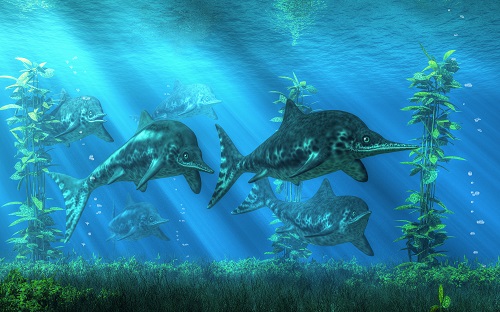Triassic era
The Triassic period, which occurred approximately 252 to 201 million years ago, is truly mind-boggling in terms of its immense timescale. When you write down the number, there are six zeros (252,000,000 million years ago)! In comparison, humanity has only been inhabiting the Earth for about 125,000 years. To put this into perspective, if we imagine the entire duration of the Triassic period as a 24-hour day, the first appearance of humans would occur just 43 seconds before midnight!
During the early stages of the Triassic period, the Earth looked vastly different. All the continents were joined together, forming a supercontinent called Pangea, which was surrounded by the Panthalassa ocean. Over time, the continents gradually drifted apart, leading to the familiar map we recognize today. Have you ever noticed how the western side of Africa could fit snugly against the eastern side of South America? It’s a fascinating illustration of the Earth’s ever-changing landscape throughout history.

The first dinosaurs
At the beginning of the Triassic period, the animal population was relatively sparse. This was a result of the previous era, the Permian, which ended with a catastrophic mass extinction event. The cause of this mass extinction is believed to be either a massive volcanic eruption or a significant meteorite impact, leading to the extinction of about 75% of animal species on Earth. This created ample opportunities for new developments and evolution, eventually giving rise to the first dinosaurs from smaller, land-dwelling reptiles around 235 million years ago. The exact species that served as the earliest dinosaurs remain unknown.
During the Triassic period, most dinosaurs inhabited regions near the coast. These areas provided abundant food and better shelter compared to the desert-like interiors of the supercontinent. In the early stages, dinosaurs had to exercise caution as they were still relatively small in size and relatively rare. Although they would later become the largest herbivores and most formidable predators, they had to coexist with other dominant species until the end of the Triassic period.
Alongside the emergence of the first dinosaurs, the Triassic period also marked the birth of the first mammals. Similar to the early dinosaurs, these mammals were small and vulnerable. Examples include creatures resembling mice, such as the Megazostrodon or Morganucodon. Nonetheless, all the mammals we recognize today evolved from these small and seemingly insignificant ancestors.
The end of the Triassic
Around 201 million years ago, the Triassic period came to an end with another mass extinction event. The exact cause of this extinction is uncertain, but it may have been linked to a shift towards a colder climate. Such changes can disrupt ecosystems by limiting plant growth, leading to food shortages for herbivores. As a result, herbivores struggle to survive, causing a ripple effect on predators who rely on them for sustenance.
Interestingly, this mass extinction event did not have a significant negative impact on dinosaurs. Being relatively small in size at the time, dinosaurs had lower energy and food requirements compared to larger animals higher up in the food chain. Mass extinctions tend to affect dominant species that require substantial resources and have extensive territories. With their competitors dwindling, dinosaurs found ample opportunities for further development and evolution during the subsequent era, the Jurassic period.

Follow us on TikTok
Wondering what your dino-friends get up to when you’re not around? Follow the adventures of your favourite dinosaurs on TikTok and other social media platforms!
Follow us on social media